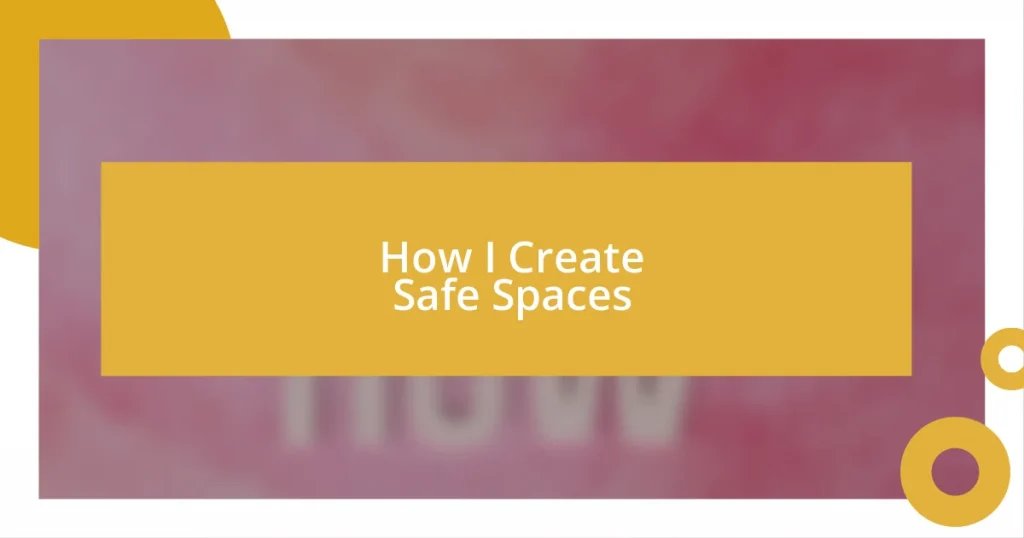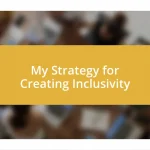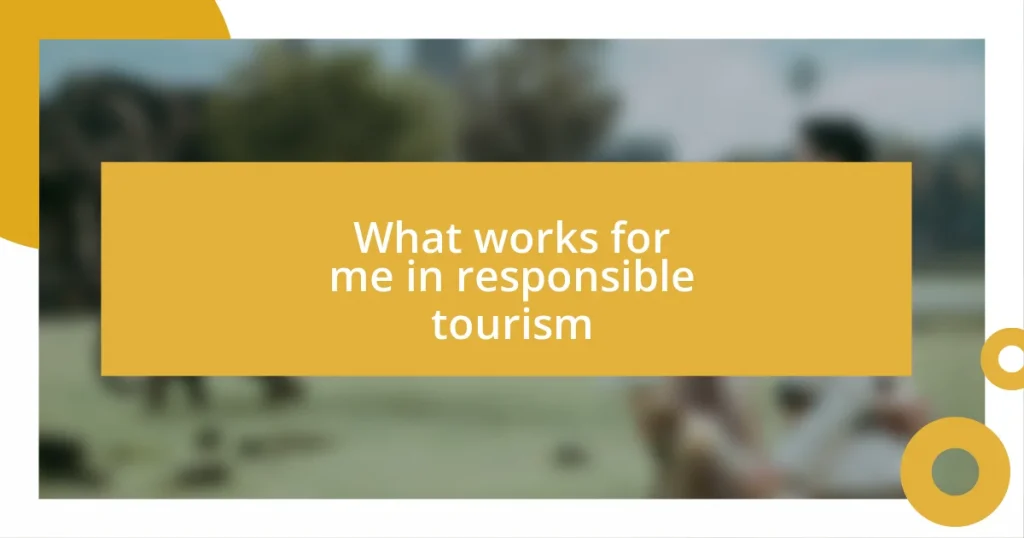Key takeaways:
- Safe spaces foster emotional openness and personal growth by creating environments of trust, authenticity, and active listening.
- Designing the physical environment, including furniture arrangement and personal touches, significantly influences participants’ comfort and willingness to engage.
- Regular evaluation and adaptation of safe spaces, based on participant feedback, enhance inclusivity and create a more supportive atmosphere for everyone involved.

Understanding Safe Spaces
When I think about safe spaces, I envision environments where individuals feel free to express their thoughts and emotions without fear of judgment. It’s fascinating how these spaces can foster deep connections; I often find myself reflecting on moments in support groups where honesty brought tears but also a sense of liberation. Have you ever experienced a moment where vulnerability felt like a warm blanket rather than a risk?
The concept of a safe space goes beyond physical location; it’s about the emotional atmosphere created by trust and respect. I remember attending workshops that emphasized active listening and empathy. Just feeling heard can transform a conversation. How often do we encounter spaces where our opinions aren’t just welcomed but genuinely valued?
Safe spaces are crucial for promoting mental well-being and personal growth. In my experience, when I’ve been in such environments, my inhibitions fade, allowing me to engage more openly. What would it be like if everyone could share their true selves without hesitation? Imagine the ripple effect of kindness and understanding that could emerge from such authenticity.

Importance of Safe Spaces
Creating safe spaces is more than just a noble idea; it’s vital for nurturing self-expression and emotional health. I vividly remember an instance in a community art class where we were encouraged to share our inspirations. The moment someone revealed their struggle with anxiety while creating, it opened a floodgate of shared experiences. That instant connection made the room feel lighter, as if burdens were lifted along with the paintbrushes. Safe spaces allow for these transformative exchanges, leaving everyone involved feeling validated and empowered.
Here are a few key reasons why safe spaces are indispensable:
- Encouragement of Authenticity: When people feel secure, they’re more likely to reveal their true selves.
- Building Trust: A safe environment fosters trust, enabling deeper relationships and understanding.
- Promoting Mental Well-Being: These spaces significantly reduce stress and anxiety, creating a calming atmosphere.
- Enhancing Self-Esteem: Validation from peers can boost confidence and encourage self-acceptance.
- Facilitating Personal Growth: Individuals can explore new ideas and beliefs without the fear of backlash or ridicule.
Reflecting on how safe spaces positively influence my life leaves me hopeful about the connections we can all build.

Identifying Your Target Audience
To effectively identify your target audience, I find it helpful to reflect on their needs and preferences. Understanding who you’re trying to reach makes a significant difference in creating a truly impactful safe space. For example, in a previous project centered around arts therapy, I discovered that my audience was primarily young adults dealing with anxiety. By focusing on their specific experiences, I tailored activities that resonated with their challenges.
Another approach I’ve taken involves engaging directly with the community I aim to serve. In one instance, I held a few informal gatherings where people could openly discuss what they sought in safe spaces. The insights gained were invaluable; I learned that my audience longed for not only a judgment-free environment but also structured activities to guide their expression. This feedback helped shape a program that aligned with their desires.
Next, I often utilize demographic data to refine my understanding of the audience. Age, gender, and cultural background play vital roles in shaping an individual’s experience. For example, in another project focused on marginalized groups, I found that incorporating elements of their cultural practices made them feel more included and valued. This detail enriched the program significantly.
| Approach | Description |
|---|---|
| Reflection | Consider the needs and preferences of the audience based on personal experience. |
| Engagement | Interact directly with the community to gather insights on their expectations. |
| Demographic Data | Utilize demographic information to tailor the safe space to diverse backgrounds. |

Designing the Physical Environment
Creating the right physical environment for a safe space is absolutely crucial. I remember when I set up a community meeting room and made a conscious choice to use warm colors and soft lighting. The moment people walked in, you could see their shoulders drop a little, as if the atmosphere itself invited them to breathe and be themselves. Isn’t it amazing how something as simple as color can change the emotional landscape of a room?
Furniture arrangement plays a significant role, too. I recall a workshop where I arranged chairs in a circle instead of rows, instantly transforming the dynamic. It created an intimate setting that encouraged eye contact and dialogue, breaking down barriers. I’ve found that people feel more connected when they’re not simply looking at the back of someone’s head. Have you ever noticed how the layout of a space can influence your willingness to share?
Adding personal touches is another effective strategy. When I include elements like cushions or artwork created by the group members, it fosters a sense of ownership and belonging. I’ve seen how these small details make participants feel like they’re not just visitors but integral parts of the space. Shouldn’t safe spaces reflect the unique identities of those who inhabit them? It’s an approach that nurtures pride and awareness, making emotional connections even stronger.

Establishing Ground Rules
Establishing ground rules in a safe space is essential for fostering trust and respect. I’ve often started by collaboratively discussing expectations with participants. For instance, in a group I facilitated, we chose to prioritize confidentiality, ensuring everyone felt secure sharing their stories. I’ve found that involving everyone in this process promotes a deeper commitment to those rules.
One memorable experience was when I organized a workshop around the theme of active listening. We collectively decided that interruptions wouldn’t be tolerated, which led to a more profound type of engagement. It was incredible to witness how this simple rule transformed the energy in the room; people felt genuinely heard, and that made all the difference in creating a supportive atmosphere. Have you ever felt the power of being truly listened to?
Additionally, I like to revisit these ground rules periodically, reinforcing their importance and adjusting them as necessary. In one community circle, we created a shared banner listing our commitments to each other. It not only served as a constant reminder but also built a sense of accountability. It’s fascinating how visual elements, like a group-created banner, can strengthen our collective identity and deepen our emotional connections within the space.

Encouraging Open Communication
Encouraging open communication is vital to cultivating a safe space. I vividly recall a small gathering where I invited people to share their thoughts without any pressure. The room buzzed with anticipation, and you could almost feel everyone’s collective nervousness dissipate as we engaged in a simple icebreaker about our favorite memories. It felt remarkable to witness how those shared moments instantly drew everyone closer, breaking the ice and allowing authentic conversations to flow.
One technique I often use is active questioning, which invites deeper dialogue. During a recent workshop, I asked participants to express their dreams for the community. Their faces lit up as they shared hopes and ideas, and the energy shifted palpably. Don’t you think it’s powerful when we give each other the space to dream freely? It opens up pathways to connect on a level that is often overlooked but essential in fostering understanding and collaboration.
To reinforce this openness, I make a habit of modeling vulnerability myself. I remember a time when I shared a personal struggle related to my work; it sparked an unexpected wave of candidness from others. The room transformed as people began to share their challenges. I find that when I lead with authenticity, it encourages others to do the same. Have you ever noticed how sharing a piece of your story can invite others to unveil theirs? It’s a beautiful cycle that enhances connections, strengthens bonds, and ultimately, creates a deeper sense of safety.

Evaluating and Adapting Spaces
Evaluating spaces is a vital step in ensuring their continuous safety and inclusivity. I recall a time when I facilitated a group session that felt off—participants seemed distracted and uncomfortable. It led me to reflect on our environment. I realized that the seating arrangement was too formal, which inadvertently created barriers. Sometimes, it’s as simple as rearranging furniture or adjusting the lighting to cultivate a more welcoming atmosphere. Have you ever noticed how a cozy setting can change the tone of a conversation?
When I evaluate a space, I actively seek feedback from participants. In one workshop, I employed a quick anonymous survey that allowed people to voice their thoughts about our setup freely. To my surprise, several noted that the space felt a bit sterile and suggested incorporating plants and artwork. Implementing their suggestions transformed the room into a vibrant haven! This experience taught me the power of listening to those who occupy the space; after all, they are the ones navigating their comfort levels.
Adapting spaces isn’t just about physical changes; it often involves emotional and social considerations too. I remember an instance where I noticed some participants weren’t engaging fully. After reaching out to them privately, they expressed feeling intimidated by louder voices in the group. This prompted me to implement a ‘turn-taking’ method for sharing, allowing everyone an equal chance to contribute. It was inspiring to witness how this small change not only encouraged participation but also led to a richer exchange of ideas. Have you ever seen how inclusivity can elevate the group dynamic? It’s a reminder that evaluating and adapting our spaces is an ongoing journey, not just a one-time fix.















